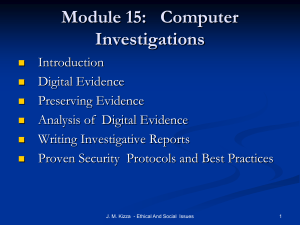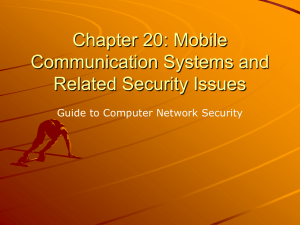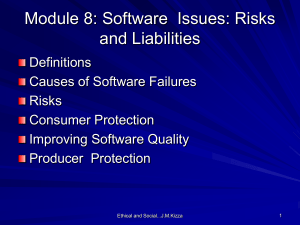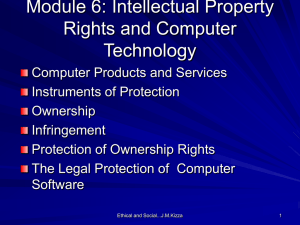chapter 13
advertisement
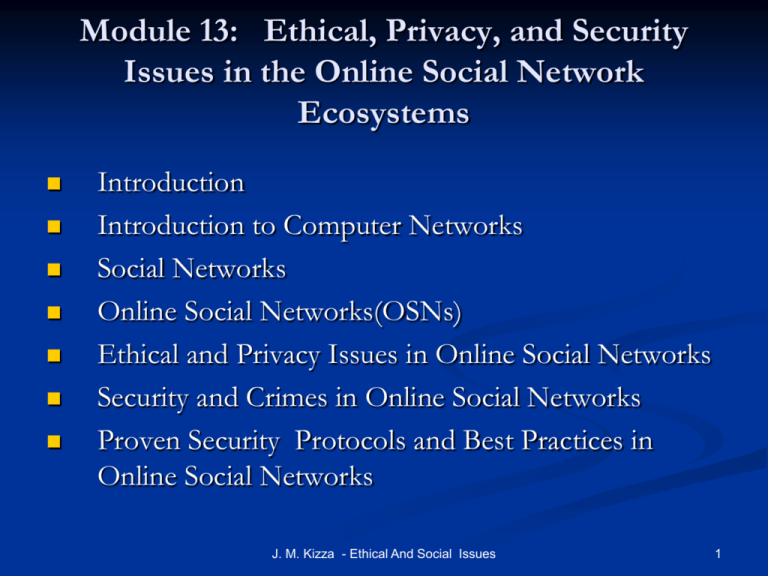
Module 13: Ethical, Privacy, and Security Issues in the Online Social Network Ecosystems Introduction Introduction to Computer Networks Social Networks Online Social Networks(OSNs) Ethical and Privacy Issues in Online Social Networks Security and Crimes in Online Social Networks Proven Security Protocols and Best Practices in Online Social Networks J. M. Kizza - Ethical And Social Issues 1 Introduction to Computer Networks A computer network is a distributed system consisting of loosely coupled computing elements and other devices communicate through a wired or wireless medium. Communication is based on a set of communicating rules called protocols. The hardware components of a computer network consist of a collection of nodes that include: Hosts – as end systems, intermediate switching elements like hubs, bridges, routers, and gateways. J. M. Kizza - Ethical And Social Issues 2 Two common network configuration models - the centralized and distributed Computer networks- centralized or distributed, come in different sizes depending on the number of computers and other devices the network has. The number of devices, computers or otherwise, in a network and the geographical area covered by the network determine the network type: Local Area Network (LAN) Wide Area Networks (WANs) Metropolitan Area Networks (MANs) J. M. Kizza - Ethical And Social Issues 3 Online Crimes An online crime is a crime like any other crime, except it involves a connected computing system either as an object of a crime, an instrument used to commit a crime or a repository of evidence related to a crime. The International Convention of Cyber Crimes and the European Convention on Cyber Crimes both list the following crimes as online crime [1]: Unlawful access to information Illegal interception of information Unlawful use of telecommunication equipment. Forgery with use of computer measures Intrusions of the Public Switched and Packet Network Network integrity violations Privacy violations Industrial espionage Pirated computer software Fraud using a computing system Internet/email abuse Using computers or computer technology to commit murder, terrorism, pornography, and hacking. J. M. Kizza - Ethical And Social Issues 4 Ways to Perpetuate Online Crimes System penetration - a process of gaining unauthorized access to a protected system’s resources, the system may be automated or not. Distributed Denial of Service (DDoS) - an interruption of service of the target system – when it is made either unavailable to users through disabling or destruction of it. Category include: IP-spoofing SYN-Flooding: Smurf attack Buffer Overflow Ping of Death Land.c attack Teardrop.c Sequence Number Sniffing J. M. Kizza - Ethical And Social Issues 5 Defense Against Online Crimes Prevention – one of the oldest and probably the best defence mechanism against online crimes. Must include the following: A security policy Risk management Vulnerability assessment Use of strong cryptographic algorithms Penetration testing Regular audits Use of proven security protocols Legislation Self-regulation Mass education J. M. Kizza - Ethical And Social Issues 6 Proven Security Protocols and Best Practices There are hundreds of security protocols and best practices in use today The problem for security professional is to find the best Major categories are: J. M. Kizza - Ethical And Social Issues 7 Authentication - a process of validating the identity of someone or something. uses information provided to the authenticator to determine whether someone or something is in fact who or what it is declared to be. requires one to present credentials or items of value to the authenticating agent in order to prove the claim of who one really is. items of value or credential are based on: something you know, something you have, or something you are: Something you know: may be something you mentally possess like a password, a secret word known by the user and the authenticator. This technique of authentication is cheap but has weaknesses like memory lapses. J. M. Kizza - Ethical And Social Issues 8 Something you have:, may be any form of issued or acquired self identification such as SecurID, Activcard, or any other forms of cards and tags. This authentication technique is slightly safer. Something you are: These are individual physical characteristic such as voice, fingerprint, iris pattern and other biometrics. Biometric authentication as we are going to see in Chapter 14 are the safest form of authentication. Authentication methods include: password public-key anonymous certificate-based J. M. Kizza - Ethical And Social Issues 9 Access Control - a process of determining how access to the system’s potential resources can be provided to each of the system users. Legislation - process of enacting laws intended to curb the growth of these crimes. Several control techniques and technologies have been developed to deal with this problem; they include: Access Control Matrix, Capability Tables, Access Control Lists, Role-Based Access Control, Rule-Based Access Control, Restricted Interfaces, Content-Dependent Access Control and biometrics. Sometimes enforceable laws can be productive. Self-regulation - individuals finding ways to regulate objectionable material from reaching the children. This has become the cornerstone of efforts to stop the growing rate of online crimes. J. M. Kizza - Ethical And Social Issues 10 Detection - mechanisms for preventing online crimes through 24-hour monitoring systems that continuously capture, analyze, and report on the daily happenings in and around the network. Recovery - a process that consists of two sub processes: Analysis involving taking as much data as possible gathered during the last intrusion and analysing it for patterns that can be used in future for a response, for detection in future, and for prevention. Recovery requiring the use of all available resources to mitigate the problem in progress, recover whatever can be recovered and build new data in place of or to replace the destroyed data. J. M. Kizza - Ethical And Social Issues 11

